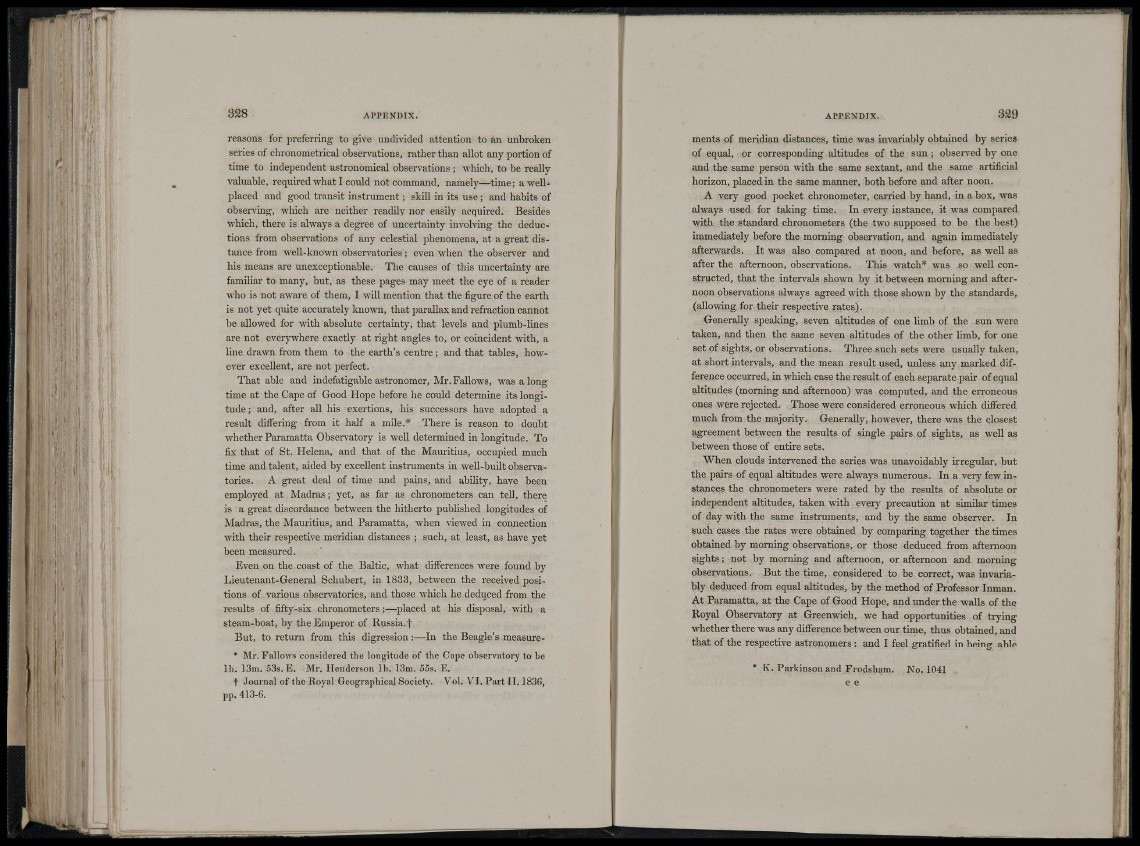
328 APPENDIX. APPENDIX. 329
,1V' l i »
WWjj r
reasons for preferring to give undivided attention to an unbroken
series of chronometrical observations, rather tlian allot any portion of
time to independent astronomical observations; which, to be reallyvaluable,
required what I could not command, namely—time; a wellplaced
and good transit instrument; skill in its use ; and habits of
observing, which are neither readily nor easily acquired. Besides
which, there is always a degree of uncertainty involving the deductions
from observations of any celestial phenomena, at a great distance
from well-known observatories; even when the observer and
his means are unexceptionable. The causes of this uncertainty are
familiar to many, but, as these pages may meet the eye of a reader
who is not aware of them, I will mention that the figure of the earth
is not yet quite accurately known, that parallax and refraction cannot
be allowed for with absolute certainty, that levels and plumb-lmes
are not eveiywhere exactly at right angles to, or coincident with, a
line drawn from them to the earth's centre; and that tables, however
excellent, are not perfect.
That able and indefatigable astronomer, Mr. Fallows, was a long
time at the Cape of Good Hope before he could determine its longitude;
and, after all his exertions, his successors have adopted a
result differing from it half a mile.* There is reason to doubt
whether Paramatta Obsen-atory is well determmed in longitude. To
fix that of St. Helena, and that of the Mauritius, occupied much
time and talent, aided by excellent instruments in well-built observatories.
A gi-eat deal of time and pains, and ability, have been
employed at Madras; yet, as far as chronometers can tell, there
is a great discordance between the hitherto published longitudes of
Madras, the Mauritius, and Paramatta, when viewed in connection
with their respective meridian distances ; such, at least, as have yet
been measured.
Even on the coast of the Baltic, what differences w^ere found by
Lieutenant-General Schubert, in 1833, between the received positions
of various observatories, and those which he deduced from the
results of fifty-six chronometers ;—placed at his disposal, with a
steam-boat, by the Emperor of Russia.f
But, to return from this digi-ession :—In the Beagle's measure-
• Mr. Fallows considered the longitude of the Cape observatory to he
Ih. 13m. 53s. E. Mr. Henderson 111. 13m. 55s. E.
t Journal of the Royal Geographical Society. Vol. VI . Part II. 183G,
pp. 413-6.
ments of meridian distances, time was invariably obtained by series
of equal, or corresponding altitudes of the sun ; observed by one
and the same person with the same sextant, and the same artificial
horizon, placed in the same manner, both before and after noon.
A very good pocket chronometer, carried by hand, in a box, was
always used for taking time. In every instance, it was compared
with the standard chronometers (the two supposed to be the best)
immediately before the morning observation, and again immediately
afterwards. It was also compared at noon, and before, as well as
after the afternoon, observations. This watch* was so well constructed,
that the intervals shown by it between morning and afternoon
observations always agreed with those shown by the standards,
(allowing for their respective rates).
Generally speaking, seven altitudes of one limb of the sun were
taken, and then the same seven altitudes of the other limb, for one
set of sights, or observations. Three such sets were usually taken,
at short intervals, and the mean result used, unless any marked difference
occurred, in which case the result of each separate pair of equal
altitudes (morning and afternoon) was computed, and the erroneous
ones were rejected. Those were considered erroneous which differed
much from the majority. Generally, however, there was the closest
agreement between the results of single pairs of sights, as well as
between those of entire sets.
When clouds intervened the series was unavoidably irregular, but
the pairs of equal altitudes were always numerous. In a very few instances
the chronometers were rated by the results of absolute or
independent altitudes, taken with every precaution at similar times
of day with the same instruments, and by the same observer. In
such cases the rates were obtained by comparing together the times
obtained by morning observations, or those deduced from afternoon
sights; not by morning and afternoon, or afternoon and morning
observations. But the time, considered to be correct, was invariably
deduced from equal altitudes, by the method of Professor Inman.
At Paramatta, at the Cape of Good Hope, and under the walls of the
Royal Observatory at Greenwich, we had opportunities of trying
whether there was any difference between our time, thus obtained, and
that of the respective astronomers ; and I feel gratified in being able
• K. Parkinson and Frodsham. No. 1041
iS